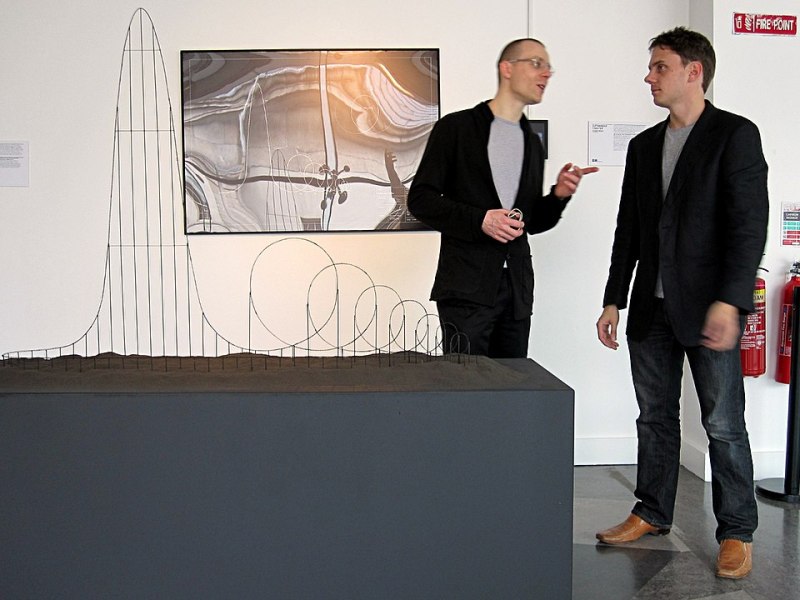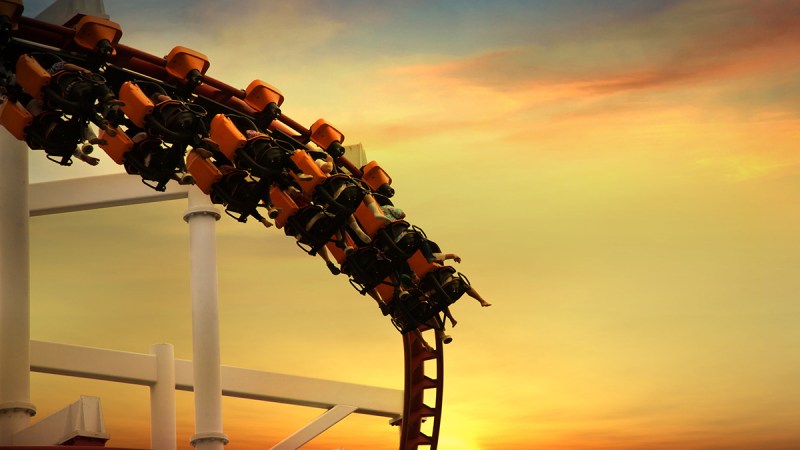
In 2011, the Science Gallery at Trinity College in Dublin hosted one of its infamous futuristic science shows. With a dollop of steampunk, a dash of mad science, and a splash of David Cronenberg, participants contributed strange creations designed to at once innovate and aggravate stagnant thought. This included human pollination suits for a post-bee world, 30 skulls with eyes that follow viewers across the room in, Uncanny Valley, a human-petunia hybrid called an Etunia, and a roller coaster.
Among all those ideas, it is the roller coaster that continues to garner attention, appearing on YouTube, Reddit, and other social media sites every few years for its kindly yet terrifying answer to unbearable life — death by thrill ride. The Euthanasia Coaster exhibit proffered a hypothetical euthanasia machine designed by Julijonas Urbonas, a Lithuanian with a kindly, twisting idea of death with “elegance and euphoria” on a euthanasia roller coaster.
A combination of high-volume visitors jumping on mechanical cars designed to take violent, twisting turns and drop many stories provides a template for a risky situation. Roller coaster accidents, however, are exceedingly rare. A long-term Consumer Product Safety Commission study estimated about 4.5 deaths at amusement parks per year. Of these, about four were roller coaster deaths, according to a 10-year look across fatalities in the U.S. This reassurance of safety is a large reason millions of people continue to seek out roller coasters as death-defying thrill rides. What Urbonas suggested was to take this one step further: what if a ride could be a person’s last exciting burst on this Earth?
“It’s a euthanasia machine in the form of a roller coaster, engineered to humanely, with euphoria and pleasure, kill a human being,” Urbonas said, presenting his 1:500 scale model in a Vimeo presentation of the Science Gallery’s 2011 event.
This incredible roller coaster would measure about 4.5 miles long and stand over 1,600 feet in the air. These components form the two key elements of the Euthanasia Coaster: a huge drop to propel the car and a series of shrinking loops that maintain a lethal speed of 10G’s. (One ‘G’ equals the acceleration of gravity, approximately 32.2 feet per second per second at sea level. The measurement is specifically used to determine the effect of acceleration upon the body.) Riding the monster would push the human body to the limit, with blood forced to the extremities for a full minute. The rider would eventually suffer g-force-induced loss of consciousness followed by death by cerebral hypoxia — a lack of oxygen to the brain. While this sounds painful, it’s quite the opposite.
“When (your brain) starts to suffocate, people usually become… euphoric because (the) brain concentrates on very vital activities,” Urbonas said.
Urbonas used his knowledge of pilot training and g-force adjustments to help build the euthanasia machine. Basically, you go “Woooh!” for a few seconds before you just pass out. This is intentional as the designer wanted to offer an alternative to “medicalized, secularized, and sterilized” palliative suicide.
“In the roller coaster, I introduced a ritual of doing that,” Urbonas continued. “Ritual is brought back to the contemporary description of death.”
In other words, you get to go out with a bang instead of being surrounded by alien machines and tubes.
While the idea of facing death is dark, providing a gentle exit to the other side remains an idea intriguing enough idea to resonate for over ten years after Urbonas proposed his humane death machine. You can even ride a virtual version of the Euthanasia Coaster, courtesy of YouTube user Kester who created a simulation on Planet Coaster in 2016:

Could you survive a ride on the Euthanasia Coaster?
First, let’s get one thing out of the way, the Euthanasia Coaster was designed only as a theoretical thought experiment and it was never intended to be built. But if such a roller coaster were to be built, there would be a chance to ride it and live to tell the tale, but you would need specialized clothing or be missing limbs to pull that off.
In an interview after the coaster was presented to the public, Urbonas said that it would be possible to “hack” the coaster and survive. According to Urbonas, after the design was released, he spoke to an engineer, who said that if riders were to wear the anti-g-force clothing that pilots wear to keep from blacking out during intense flights, they would be able to live through the ride. Additionally, Urbonas said it would be possible for amputees or quadriplegics to survive because their lower bodies don’t have enough volume to pool the blood necessary to kill the rider.
Either way, I think I’ll just stick to Space Mountain.



